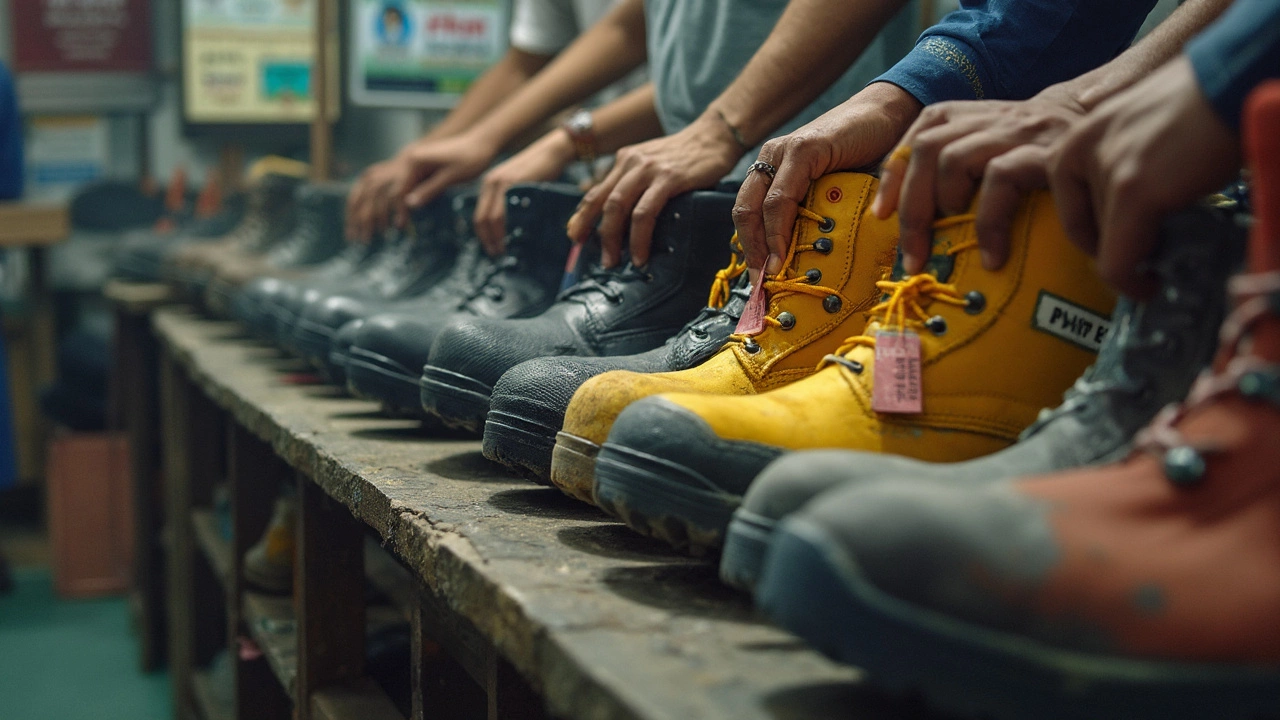Picture this: It’s your first day on a busy construction site, a noisy warehouse, or maybe even a machine shop with sparks flying. You show up with your best sneakers—only for your supervisor to frown and point at your feet. “Safety boots,” he says. “You’ll need ‘em here.” Now the real kicker: Who pays for those shoes? You, the one clocking in, or the company that hired you? This is one of those practical, sometimes prickly questions that almost everyone in a tough work environment will eventually face. It's not just about the $80–$200 price tag, either; it’s about your rights, your safety, and not getting blindsided.
Workplace Safety Gear: What the Law Actually Says
This isn’t just a judgment call from your boss. There’s real law behind those steel toes. In the US, the Occupational Safety and Health Administration (OSHA) spells out exactly when employers have to pony up for personal protective equipment (PPE). Here’s the thing: As early as 2008, OSHA made it crystal clear—when the job requires PPE to keep you safe, the employer usually has to pay for it. There’s a long, detailed regulation about this. But the gist? If wearing safety shoes is a job requirement to shield your toes from flying hammers, dropped pallets, or chemical spills, your employer is on the hook.
But of course, there are fine print exceptions. If you choose to buy fancier boots for style or personal reasons, or if you want to upgrade to some ultra-no-slip soles, that’s often on you. OSHA even lists safety-toe footwear as a ‘specialty’ item, which means employers must pay up when it’s needed for the job. Want the hard proof? You can check OSHA standards 1910.132(h). Also, across Europe and Canada, employers typically foot the bill if they want you to wear safety footwear for your job. Policies can differ across countries, though, and even between states if you’re in the US. But if it’s required for safety—your boss rarely has a choice.
Exceptions, Loopholes, and What Most Companies Actually Do
Now, here’s where the water gets muddy. Yes, the law says, “Employer pays for PPE,” but there are caveats. Let’s say you’re working at a job that suggests safety shoes but doesn’t absolutely require them for every task. Or maybe you show up to a new gig already owning your own work boots, and you want to use those. In these cases, some companies will offer a stipend, sometimes called a “boot allowance.” This can range from $50 up to $200 per year, and some jobs refresh this every 12 months, while others only pay the first time.
But employers aren’t obligated to pay for shoes that are also worn off the clock. So if you get a sweet pair of composite-toe boots and wear them while hiking after work, your boss might not cover that purchase. According to a survey by the National Safety Council, about 60% of workplaces that require safety footwear provide either direct reimbursement or vouchers. The rest expect employees to bring their own. And if a company does buy boots for you, they might insist you wear only that specific brand or style. That means no swapping boots with your favorite skull-printed ones, even if they’ve got toe caps.

How Workplaces Decide: Industry Traditions and Company Policies
Rules might be rules, but let’s get real—your experience can depend on the workplace vibe or industry norm. Heavy construction? Long-haul trucking? Oil refineries? These places rarely mess around when it comes to safety, and they almost always provide the boots. Workers in these fields face risks from sharp objects, tons of weight, and caustic chemicals, so the boss usually plays it by the book. Retail warehouse jobs, manufacturing lines, shipping docks—these vary more. Some big corporations have formal PPE programs with clear allowances. For example, UPS, FedEx, and some auto plants provide annual footwear stipends, while smaller businesses might hand you a list of shoes that “meet requirements” but leave the buying to you.
There’s also the union factor. Union jobs often negotiate robust safety gear benefits, including free or discounted footwear—sometimes even replacements if your shoes get wrecked on the job. But in non-union workplaces, it can be patchier. Some bosses follow minimum legal standards, while others go above and beyond to keep employees safe and happy (retention, after all, is cheaper than hiring new staff all the time).
Here’s a pocket guide to typical approaches:
- Safety-critical jobs (construction, mining): Company pays, either upfront or with an allowance.
- Manufacturing/warehouse: Usually a stipend or voucher system, sometimes with limits on brands or styles.
- Entry-level retail or grocery: Employee usually buys their own unless heavy lifting is required.
- Healthcare (hospital maintenance/janitorial): Slip-resistant shoes may be required; coverage varies.
Another tidbit: In hospitality and restaurant work, slip-resistant shoes are often “highly recommended” but not always company-funded—unless tipped workers unite and demand it. Among salaried professionals, like lab scientists or engineers, high-spec footwear might be provided during onboarding just to avoid paperwork if someone gets hurt.
Hidden Costs and What to Watch Out For
The reality is, buying work boots isn’t just a hit to your wallet—it can get complicated. You want to avoid buying a cheap pair just to meet the rules, only to have them fall apart in three months. That’s why many smart companies offer approved lists featuring shoes with ASTM or CSA certifications (these are real-deal safety standards), so you don’t end up with duds.
Watch out for policies that sound generous but hide pitfalls. Some employers only reimburse after you’ve worked a certain number of months. Others require you to submit a dozen receipts or go through a clunky portal hidden somewhere in the company intranet. I’ve heard plenty of stories about workers being told “pick up any old boot” before HR sends back a denial letter because the toe cap isn’t steel or the sole isn’t ESD-rated (for static electricity—yes, that’s a thing).
There’s a big market in “discount” safety footwear that promises compliance for less. But a 2023 report by the American Society of Safety Professionals found that 25% of failed workplace safety audits involved substandard footwear bought independently. That means if your shoes don’t meet code and you hurt yourself, you might not be eligible for workers’ comp.
Here’s a quick cost comparison of safety footwear types and average employer coverage:
| Type of Safety Shoe | Avg. Market Price (USD) | Typical Allowance Offered |
|---|---|---|
| Steel-toe Boots (Basic) | $60–$110 | $50–$100 |
| Composite-toe Boots (Advanced) | $100–$170 | $70–$150 |
| Slip-resistant Shoes | $45–$90 | $30–$80 |
| Chemical-resistant Boots | $80–$220 | $60–$200 |

Making Your Case: How to Get Employer Support (and Better Quality Shoes)
So, what if your boss drags their feet about paying for sturdy, legal PPE? You don’t have to grin and bear it. First, know your rights: If safety boots are required, OSHA is clear—employers should pay. If you’re getting pushback, take these steps:
- Ask for the written company policy or handbook section on PPE. Most HR departments have this, even if the info is buried.
- If there’s confusion, point your manager to OSHA regulation 1910.132(h). Sometimes, they just don’t know the specifics.
- Unionized? Contact your rep. They live for this stuff and can escalate your request fast.
- No union? If you feel unsafe or unfairly treated, you can file a confidential OSHA complaint (and it’s illegal for your boss to retaliate). But use this as a last resort—once HR is involved, things usually get sorted quickly.
- Keep all receipts and emails. If you’re told to buy your own, document exactly which style, brand, and safety markings you purchase in case reimbursement is offered later.
- Join in on PPE test days if your company offers them. Sometimes, vendors come in, measure everyone, and fit the crew to the right boots for free.
If you do have to buy your own due to a gray area (like temp jobs or mixed duties), consider investing a little more in shoes with good arch support, real safety ratings, and a warranty. Cheap boots wear out fast and can leave you with sore feet, blisters, or worse. A pair that costs $40 more might save you months of back pain and medical bills.
It pays to network, too. Coworkers who’ve been around can steer you to stores with employer partnerships or seasonal PPE sales. Don’t be shy about asking which models are comfy for 12-hour shifts, either—everyone’s got a horror story about a “discount” boot that shredded their heels.
The bottom line: If your job needs safety shoes to keep your toes attached and your body unbroken, odds are your boss should cover you. Loopholes and exceptions exist—but they’re smaller than you’d think. So next time someone says, “Those boots are on you, buddy,” ask them if they’ve read the rules. Or just show them your steel toes and smile, knowing you—and your feet—are covered.

